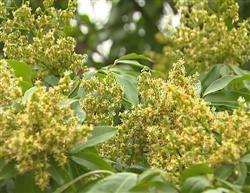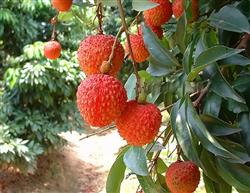Management of Litchi in August and September

All the postharvest management of litchi revolves around the purpose of cultivating strong autumn shoots. Litchi autumn shoot as the fruiting mother branch in the coming year, its shoot period and sturdiness (nutrient accumulation level) will directly affect the control of shoot to promote flower and flower formation. From the situation of production investigation, at present, the litchi trees in our city have generally taken out the first shoots after harvest, the earlier ones are close to maturity, most of them have turned green or are about to turn green, and very few have just sprouted or not germinated. In recent years, many fruit growers do not pay enough attention to postharvest management, less fertilization or partial application of nitrogen fertilizer, short fertilizer efficiency and extensive pruning, resulting in too much shoot germination and weak shoot quality. The continuous rainfall in June delayed the recovery of root system, and the root system was not active enough, which affected the absorption and transport of nutrients. In addition, due to the excessive temperature in July, the respiration consumption of the tree is too high, and it is difficult to accumulate nutrients, so it is found that the turning green leaves are thinner, which will increase the difficulty of controlling shoots and promoting flowers to some extent. Therefore, on the basis of continuing to do a good job of pruning, the main task at the present stage is to pay attention to the prevention and control of diseases and insect pests, classify management according to tree age and tree potential, reasonably regulate fertilizer and water, and consciously adjust the emergence time of the last shoot. First, continue to do a good job in pruning. Pruning is the focus of the whole postharvest management period, until controlling shoots and promoting flowers, we should make unremitting efforts to form a moderate and reasonable tree crown and cultivate robust fruiting mother branches. (1) the unfinished pruning in the first round of postharvest pruning should be carried out as soon as possible. For pruning methods, please refer to the 6th and 7th issues of Fruit Science and Technology in 2005. (2) on the basis of the completion of the first round of postharvest pruning, in view of the new shoots currently extracted, the pruning work should be mainly thinning, cutting off too dense branches, shade branches, withered branches, disease and insect branches, too weak erect branches, etc., strong and prosperous trees can retain shade branches appropriately to contain the over-strong top dominance, and the shade branches of too weak trees can also be slightly delayed. Make the orchard ventilated and transparent as far as possible to improve the photosynthetic efficiency. Conscientiously do a good job in pruning and sprouting new shoots. In principle, only 2 new shoots are left on each base branch, the rest are erased, and individual stronger trees can be left to 3 branches to control overgrowth. Strong trees should be selected to leave buds, properly truncated; over-strong trees should be selected to leave weak branches and weak buds, erect strong and strong branches, oblique flat branches, and appropriate more branches at the top; mediocre trees should also choose to leave buds; weak branches can be left with buds and strong branches, and some erect branches should be retained appropriately. Second, strengthen the management of fertilizer and water. (1) if the tree potential is poor and the new shoots are short and weak, they should quickly apply rotten fertilizer and water, supplemented with a small amount of nitrogen fertilizer, to promote the green color of leaves and the elongation of new shoots, so as to prevent the old leaves from falling off. Properly combined with weeding and shallow loosening soil to stimulate the growth of new roots and improve the ability to absorb nutrients. In addition, foliar can be sprayed with a certain amount of calcium fertilizer, biological chicken soup, rare earth amino acids and other foliar fertilizer. (2) for strong and prosperous trees, attention should be paid to controlling fertilizer and water so as to prevent shoots from growing. If you plan to put the shoots three times, you should apply a small amount of potash fertilizer and compound fertilizer after the first batch of shoots mature. (3) for the mediocre tree, a small amount of potash fertilizer and a small amount of potassium dihydrogen phosphate can be applied to increase the thickness of the branches. If you plan to leave the shoot for three times, you should increase the supply of fertilizer and water after the second shoot is pulled out, so as to ensure that the third shoot is pulled out as soon as possible. Third, continue to do a good job of thinning in densely planted orchards and promote the optimal allocation of resources. Fourth, consciously regulate the apical period. For most orchards, the goal is to leave shoots twice after harvest, which is beneficial to tree recovery and accumulation. those who shoot earlier can turn the soil deeply after the first shoot is mature, eradicate weeds and postpone the germination of the second autumn shoot. it is also possible to try to spray growth retarders such as low concentration dwarftin after the first shoot is ripe, which can not only delay the shoot, but also increase the branch thickness and leaf thickness. If you plan to leave the shoot for three times, you can root out the weeds in the tree plate after the first shoot is ripe and loosen the soil appropriately, but the weeds outside the tree plate should be retained as far as possible to avoid excessive drought in the surrounding environment and increase the supply of fertilizer and water. and each shoot is best to carry out foliar topdressing and improve shoot quality. when the second and third shoots just turn green, try to use high concentration of vitality or low concentration of dwarfin to promote new shoots to mature as soon as possible. The internodes are shortened and the branches are thickened. For the young trees just planned to be put into production, it is not suitable to pursue the number of new shoots and control the excessive expansion of the crown. In the near future, we should apply more phosphorus and potassium fertilizer, properly prune, weaken the growth potential, increase the accumulation of nutrients, and adjust the shoot period, which is beneficial to the formation of flowers next year. Fifth, prevent and control diseases and insect pests and protect new shoots. Litchi autumn shoot pests are mainly leaf-eating pests such as inchworm and poisonous moth, and red spiders, gall mites, gall mosquitoes and tea wood bark beetles in weak trees and shaded orchards also occur more frequently. Biqiaoling, no pardon, big agricultural fruit pest killing, litter nemesis, litchongqing, trichlorfon, isocarbophos and other pesticides can be selected to avoid single and continuous use of pyrethroids pesticides to avoid drug resistance.
- Prev

Techniques of protecting Flowers and fruits in Litchi
Problem: at present, it is the season for litchi flowering, pollination and fruit setting. Many farmers report that it is very difficult to protect flowers and fruits due to the cold weather this year. Damao Town, Wanning City, has nearly 300 mu of litchi fruit protection problem, and more than 200 mu of litchi is too old to bear fruit. Fruit farmers are too anxious to eat and sleep. I hope litchi experts in our province can give technology.
- Next

Key points of Management of Litchi Longan fruiting trees
First, do a good job of postharvest management. 1. Timely harvest. When picking fruit, one fruit should be cut twice. First, cut the ear together with the base of the fruiting branch, or even the base of the branch below the fruiting branch, and then cut off the ear. The branches below the ear do not shrink much, depending on the growth of the mother branch, and the ones that grow well are shortened.
Related
- Moge, come on! The staff of the peasant association in the producing area of cantaloupe were frightened when the crowd gathered.
- Causes and Solutions of low Fruit setting rate of Apple
- Symptoms and control measures of passion fruit virus disease
- Fruit growing lesson: how do apple orchards keep high yields?
- Can you build orchards in the mountains? What are the pros and cons?
- How to manage the coloring period of Crisson grape?
- This paper introduces the processing technology of two kinds of fig products.
- How much is a month for retired teachers in rural areas by 2020?
- How can strawberry planting increase sugar content? We should pay attention to management in many aspects.
- What are the cultivation techniques on how to improve the yield of golden fruit?

